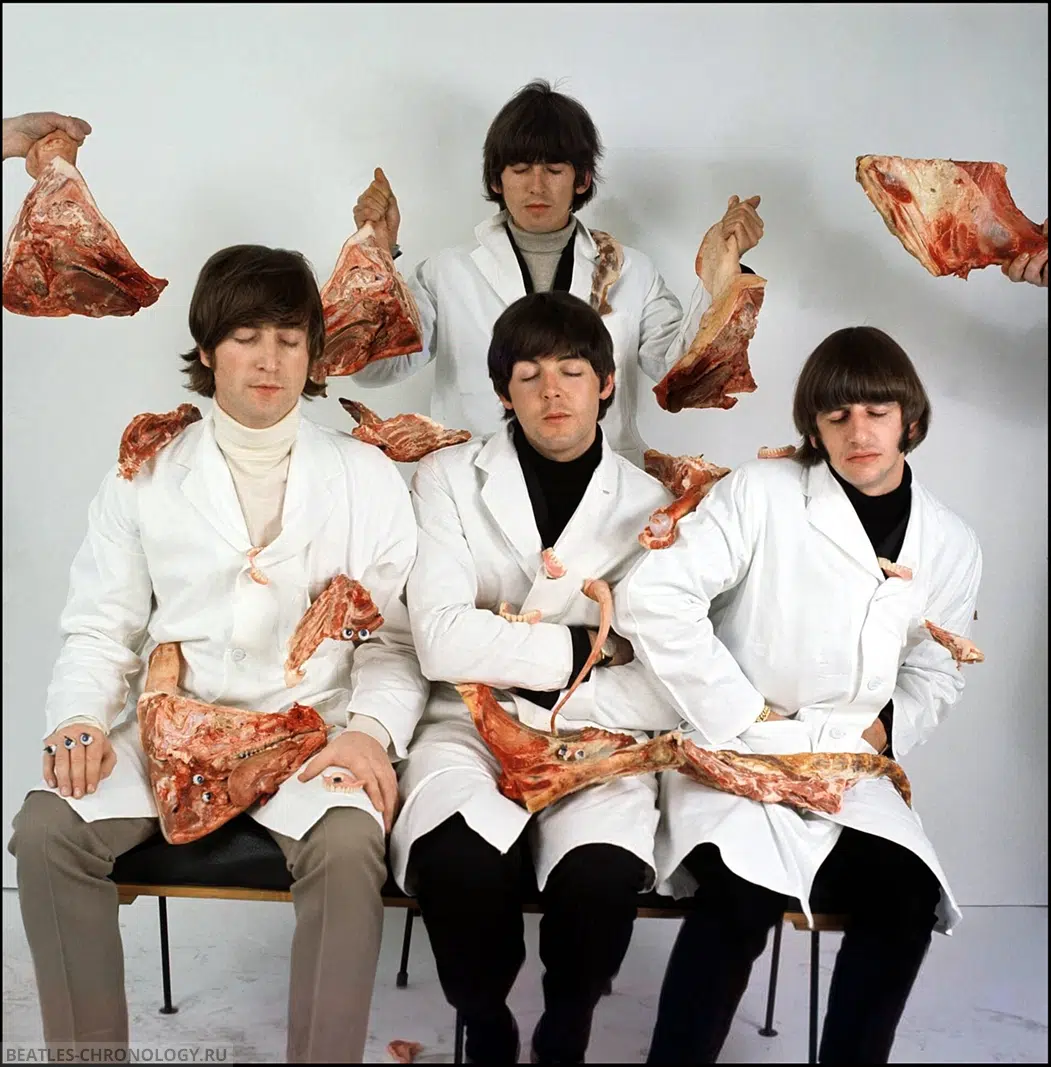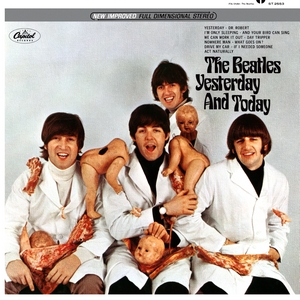The Beatles Butcher Cover: How a US Only Album Became The Most Expensive Sleeve In Music
- Anna Avis
- 18 hours ago
- 9 min read

You would not think four men in white smocks could panic a record label. Yet in June 1966, the Beatles posed in butcher coats for a photo they thought was witty and strange, and America lost its cool. That one picture turned a routine US only compilation into a saga of recalls, paste overs, whispered rumours about hidden artwork, and the birth of a genuine collector obsession. More than half a century later, Yesterday and Today still carries that aura. It is the album that should have been a footnote but instead became a legend.
Billboard Magazine June 25, 1966 ‘Salesman of the various Capitol records Distributing Corp’s branches are recuperating from a busy weekend spent stripping the latest Beatles album, “The Beatles Yesterday And Today’. Some 750,000 albums, which were pressed, packaged and shipped to the factory branches, have been recalled for repackaging. Reason for the recall is the cover art, which shows the Beatles in white smocks surrounded by what appears to be dismembered baby dolls and butcher shop cuts of meat. According to some reliable reports, none of these albums have reached dealer shelves, although some have been received by reviewers and rack jobbers. Capitol has a new cover printed, showing four nearly neatly dressed Beatles inside and draped around a trunk. Alan W. Livingstone, president of Capitol Records, explained the cover recall: “The original cover in England was intended as ‘pop art satire’. However, a sampling of public opinion in the United States indicates that the cover design is subject to interpretation. For this reason, and to avoid any possible controversy, or undeserved harm to the Beatles’ image or reputation, Capitol has chosen to withdraw the LP and substitute a more generally acceptable design. Meanwhile, Capitol is making a painstaking effort to recall the covers to make sure they are destroyed. Reviewers are requested to return the cover to Capitol, and dealers who have received streamers are asked to hold them until a salesman calls.
That paragraph has become one of the most quoted dispatches in music history. The Butcher Cover had arrived, and so had the storm.
What Yesterday and Today actually was in 1966
Yesterday and Today was a North American only studio release from the Beatles that landed in June 1966. On Capitol it was their ninth album for the label and their twelfth American release overall. In the United States and Canada it was standard practice up to 1967 for Capitol to build Beatles LPs from recent UK Parlophone albums and contemporary singles, trimming and resequencing to suit a shorter US format and the American taste for more frequent product.
This album followed that pattern exactly. It brought together eleven tracks from different sessions and phases. You got two from Help, four from Rubber Soul that had not yet been used in the US album configurations, both sides of the December 1965 double A side single Day Tripper and We Can Work It Out, and three brand new 1966 Lennon songs that the rest of the world would know as Revolver material later in the summer. The title nods knowingly to Yesterday, the enormous Paul ballad that had dominated radio the previous autumn.
In other words, Yesterday and Today is a snapshot of the band in motion between mid 1965 and mid 1966. American folk and country colours are still present on a few tracks, while other songs already point toward British psychedelia with sharper lyrics and new studio textures. You can hear the transition from rubbery folk rock to the strange and brilliant sound world that was about to explode on Revolver.

Why the Butcher Cover happened at all
Photographer Robert Whitaker had become a familiar creative partner by early 1966. On 25 March he staged a conceptual session in his Chelsea studio called A Somnambulant Adventure. He wanted to poke at the weirdness of fame and the way pop stars were turned into icons and commodities. The Beatles were bored with ordinary promo photos and were more than up for it. Out came the props. A birdcage on George’s head. A hammer and long nails posed over John’s skull. False teeth and glass eyes. Trays of meat. White coats. Dismembered baby dolls.
Whitaker envisaged a triptych layout, almost like a modern religious icon, with halos and metallic colours and a central image reduced to a small square set in a field of gold. The meat could suggest fans devouring their idols, or the raw material of image making. The false eyes and teeth could stand for the fakery of celebrity. The Beatles understood the black humour and liked the absurdity. John and Paul would later insist that, when used as an album sleeve, the picture also carried an anti war edge. To them it could be as relevant as Vietnam, and as sharp a comment as any pop star might dare to make on a sleeve in 1966.
Capitol initially preferred one of Whitaker’s more conventional shots of the band draped around a steamer trunk. But John pushed for the butcher image. Brian Epstein pressed the point, and astonishingly the label agreed. Printing plants got to work.

Operation Retrieve and the fastest paste over in show business
The rest you know in outline, but the detail is instructive. Capitol prepared roughly three quarters of a million copies with the butcher artwork. The album was set for a mid June street date. Advance copies were sent to radio, reviewers, and branch offices. Retailers saw it and balked. Family stores did not want it in racks. Salesmen got on the phone. The label panicked.
On 10 June they launched a coast to coast recall. Promotional posters were pulled. Streamers were held back. The company swallowed a vast production loss and then tried to claw back some costs by pasting the safer trunk photo over the butcher slicks rather than junking everything. Within a week, by 20 June, the revised sleeve was on sale. The most famous paste over in record shop history had begun.
Contrary to the line in Billboard that no copies reached dealer shelves, a modest number did. Some made it briefly to the bins of a few chains and independents before the salesman came knocking. A handful were sold at the till. That small leakage plus the paste over tactic created three distinct states that now define the collector market.
First state, second state, third state what they mean and why it matters
First state means an original butcher sleeve that never had a replacement glued on top. These are the crown jewels. Sealed stereo copies from certain plants are almost mythical and command extraordinary prices. Second state means a paste over that remains intact, where trained eyes can sometimes see clues in the right place beside the word Today, most famously the faint edge of Ringo’s black V neck peeking through the white area near the trunk lid. Third state means a paste over that has been carefully peeled to reveal the butcher image beneath. Values vary with the quality of the peel and the condition of the cardboard and inks.
Plant codes and numbers on the back near the RIAA seal also matter. Los Angeles, Scranton, Jacksonville each had quirks in slick stock and glue. Mono copies outnumbered stereo by a wide margin, making clean stereo survivors much rarer. The story is full of human touches too. Alan Livingston of Capitol reportedly kept a case of untouched first state copies in his closet, later released to market by his family. Auction records tell the rest, with pristine first state stereo copies hitting six figures in the modern era.
A quick buyer warning from the experts
If you find a trunk cover and suspect there is a butcher image beneath, do not try to peel it yourself. There are professionals who can do this with minimal damage. Heavy hands turn a four figure cover into a heartbreak in minutes.
The UK angle and the wider media reaction
The butcher image was visible in Britain too, though not on an album. The photo was used in press adverts and magazine covers to promote Paperback Writer. The version seen in some UK outlets lacked the doll parts but kept the raw meat, which was provocative enough. British readers wrote to complain. American trade press called it nauseating. Record buyers were confused or delighted depending on their taste for gallows humour and pop art.
Some industry voices argued that the sleeve was a comment on Capitol itself for butchering the band’s UK albums into different American formats. Among fans that view had some traction. On tour in August, the Beatles were already being criticised in the US for John’s remark about the band being more popular than Jesus, for perceived slights to political families in Asia, and for a general sense that the innocence was over. The butcher cover seemed to confirm to critics that the group had grown contemptuous of the audience. The band would soon leave the stage for good and focus on records.
Release, sales, and what happened next
Even with the recall, Yesterday and Today did what Beatles albums did in 1966. It topped the Billboard album chart for five weeks from 30 July, displaced Frank Sinatra, and sold in vast numbers. The Recording Industry Association of America certified it a million seller that summer, and later multiplatinum. Across the rest of the year the Beatles toured America for the last time, with Nowhere Man, If I Needed Someone, Day Tripper, and Yesterday in the set.
As the compact disc era dawned, the US only albums were gradually tidied away. By the early nineteen nineties the Capitol configurations were largely deleted, with the global standard becoming the UK catalogue plus Past Masters for the non album sides. That might have been the end for Yesterday and Today but the story has a neat coda. In 2014 the album returned on CD as part of The U S Albums box, and also as a standalone disc, complete with the butcher image on the book and a trunk sticker inside. Some mixes on that issue differ from vintage Capitol pressings, which keeps the message boards lively.
What these albums sell for today
Prices vary with condition, pressing plant, stereo or mono format, and provenance, but a simple rule holds true: stereo copies bring a premium, sealed copies bring a bigger premium, and first state examples are the ultimate prize. Clean first state mono sleeves typically sell in the range of $8,000 to $40,000, with sealed examples fetching more.
First state stereo copies can command $25,000 to low six figures, and truly exceptional sealed stereo copies have sold for around $125,000. Second state paste-overs that remain unpeeled often range from about $1,500 to $10,000, depending on condition and how clearly the Ringo V-neck telltale is visible, with stereo versions usually worth three to five times as much as comparable mono. Third state peeled covers vary widely depending on the quality of the peel, from a few hundred to several thousand dollars for clean, professionally lifted examples.
Ordinary trunk covers with no butcher art beneath usually sit at the more affordable end of the spectrum, unless they are immaculate promos or still in tight original shrink. Extras and provenance can move the needle sharply: early timing strips, original price stickers, plant codes tied to scarcer runs, untouched shrink with breathing holes, or a documented chain of ownership such as the Livingston copies can all add a significant premium. As ever, expert grading and authentication matter, and even a small improvement in condition can mean a very large jump in value.
What it all means now
Yesterday and Today began life as a typical Capitol patchwork for the North American market. The sequencing is not what the Beatles intended in Britain, and three Revolver songs were borrowed to feed a voracious US release schedule. Yet as a listening experience it captures a thrilling pivot in the band’s development, from folk tinged rubber and wood to fierce, peculiar colour. As a cultural artefact it tells another story entirely.
It shows how the Beatles and artists like them were beginning to clash with corporate caution. It shows how pop art ideas could upset mainstream commerce. It shows the moment the group’s humour and darker sensibilities collided with a public that was used to sunny smiles and neat suits. Most of all it shows how a single image can reshape the fate of an object. Without the butcher sleeve, Yesterday and Today would be one more US only compilation of the sixties. With it, the album became a treasure hunt, a mystery under glue, and the most famous recall in record shop memory.
For collectors, first state copies remain bucket list prizes. For historians, the paste over tells a tale about control and presentation. For listeners, the record still delivers. Drive My Car grins. Nowhere Man glows. Day Tripper snarls. I am Only Sleeping drifts. And Your Bird Can Sing shows off those guitars like bright wings. Even in a collage, the Beatles found coherence through sheer quality.
Sources
Beatles Bible overview and session history
Billboard Magazine archive report 25 June 1966
https://worldradiohistory.com/Archive-All-Music/Billboard/60s/1966/Billboard-1966-06-25.pdf
Mojo features on Robert Whitaker and Yesterday and Today
Goldmine Magazine Beatles collectables
The Beatles The U S Albums 2014 release notes
Recording Industry Association of America certifications
Heritage Auctions past sales results Beatles butcher cover
Disc and Music Echo and NME archive advertising for Paperback Writer
https://www.americanradiohistory.com/UK/Disc/1966/Disc-1966-06-11.pdf
https://worldradiohistory.com/UK/New-Musical-Express/1966/NME-1966-0603.pdf
Joe Bosso for MusicRadar on US album configurations
Nicholas Schaffner The Beatles Forever publication commentary
Tim Riley The Rolling Stone Album Guide and commentary
American Songwriter on classification of Yesterday and Today







































